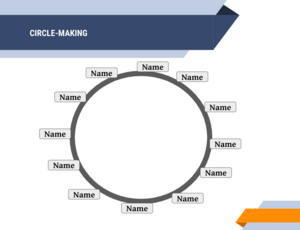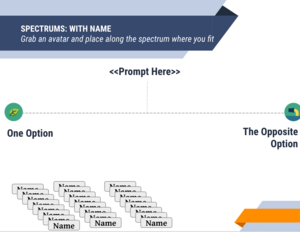Facilitation 101: Difference between revisions
| Line 101: | Line 101: | ||
= Tools for increasing participant engagement = | = Tools for increasing participant engagement = | ||
The following is a compilation of suggestions from Seeds for Change''' <ref>https://www.seedsforchange.org.uk/facilitationmeeting</ref> '''''', '''Amara Possain (HUB advisor and Daniel Hunter (350.org training director) <ref>https://trainings.350.org/resource/online-monster-manual/</ref> . Suggestions are relevant to virtual, in-person and hybrid meetings and events. | The following is a compilation of suggestions from Seeds for Change''' <ref>https://www.seedsforchange.org.uk/facilitationmeeting</ref> '''''', '''Amara Possain (HUB advisor and Daniel Hunter (350.org training director) <ref>https://trainings.350.org/resource/online-monster-manual/</ref> . Suggestions are relevant to virtual, in-person and hybrid meetings and events. | ||
{| class="wikitable" style="font-size: 14.4px; width: 85.3371%; height: 259px; border-color: rgb(0, 0, 0);" | {| class="wikitable" style="font-size: 14.4px; width: 85.3371%; height: 259px; border-color: rgb(0, 0, 0);" | ||
|- style="height: 55px;" | |- style="height: 55px;" | ||
| style="width: 14.001%; background-color: #c51f84; border-color: #000000; height: 55px;" | | | style="width: 14.001%; background-color: #c51f84; border-color: #000000; height: 55px;" | | ||
| Line 109: | Line 109: | ||
*Use the opening to build trust and ground attendees. | *Use the opening to build trust and ground attendees. | ||
*For in-person meetings, assign a welcomer or ‘doorkeeper’ for newcomers who can point people towards refreshments, explain where the toilets and fire exits are, and bring late arrivals up to speed with the meeting/event progress. | *For in-person meetings, assign a welcomer or ‘doorkeeper’ for newcomers who can point people towards refreshments, explain where the toilets and fire exits are, and bring late arrivals up to speed with the meeting/event progress. | ||
*Make sure people know how the meeting works. Explain the time frame, subjects, goals of the meeting/event and the process for making decisions. Agree with the group what behaviour is acceptable/not acceptable (e.g. avoiding jargon, asking questions if you don’t understand, trying to understand someone’s views even when you disagree with them.) | *Make sure people know how the meeting/event works. Explain the time frame, subjects, goals of the meeting/event and the process for making decisions. Agree with the group what behaviour is acceptable/not acceptable (e.g. avoiding jargon, asking questions if you don’t understand, trying to understand someone’s views even when you disagree with them.) Review, make any changes, then agree to move ahead with meeting. | ||
*Ideally include approx. time markings when explaining how the meeting/event will run. Note: Consider the dance of time; give a range of time to help people get a sense for how long you'll spend on things, but also balance when more or less time needs to go to certain things | |||
| style="width: 25.8409%;" | | | style="width: 25.8409%;" | | ||
<br> | <br> | ||
| Line 128: | Line 129: | ||
<span style="color: rgb(255, 255, 255);">'''During the meeting/event'''</span> | <span style="color: rgb(255, 255, 255);">'''During the meeting/event'''</span> | ||
| style="height: 82px; width: 46.8554%;" | | | style="height: 82px; width: 46.8554%;" | | ||
*Start with something easy to build momentum, then move on to harder items. Finish with something short and easy to provide hope for next time. | |||
*Alternate structures / modes so there are many ways to participate. | *Alternate structures / modes so there are many ways to participate. | ||
*Make the agenda visible to participants at all times. Refer to it and the time markings when possible. | |||
*Break things up and take breaks, especially in longer meetings/events with many big and/or difficult items. | *Break things up and take breaks, especially in longer meetings/events with many big and/or difficult items. | ||
*Break up who is speaking - arrange for others to present whenever possible. | *Break up who is speaking - arrange for others to present whenever possible. | ||
*Probe and test for agreement when decisions need to be made - be suspicious when agreements are reached too easily. | *Probe and test for agreement when decisions need to be made - be suspicious when agreements are reached too easily. Notice and celebrate when we do get agreement — even small ones! | ||
*Use the spectrum tool. It helps gauge where people are at. If you're virtual, you can also do this anonymously with figures instead of names. | *Use the spectrum tool. It helps gauge where people are at. If you're virtual, you can also do this anonymously with figures instead of names. | ||
*Use stickies (virtual on slides or in-person) to allow participants to share ideas. | *Use stickies (virtual on slides or in-person) to allow participants to share ideas. | ||
** | **<em style="font-size: 14.4px;">Online tips: Turn on captions, stay off mute in smaller groups, have people call on the next person in a go-around.</em> | ||
| style="width: 25.8409%;" | [[File:Screen Shot 2023-07-07 at 11.04.11 AM.png|300x300px|left|middle|border]]<p>Spectrum tool</p> | | style="width: 25.8409%;" | [[File:Screen Shot 2023-07-07 at 11.04.11 AM.png|300x300px|left|middle|border]]<p>Spectrum tool</p> | ||
|- style="height: 48px;" | |- style="height: 48px;" | ||
Revision as of 20:26, 8 August 2023
This page was created to provide tips and suggestions for activists related to facilitating meetings and events. This guide reflects several questions the HUB community has raised on facilitation.
The information included comes from existing organizer databases and resources and advice from movement thinkers. A special thanks to HUB advisor Amara Possain, who thoughtfully shared their expertise with the HUB team. Their knowledge is shared throughout. We encourage readers to share further ideas on how this page can be expanded upon and improved.
This guide includes... definers of good vs bad facilitation, tools for good facilitation, suggestions for increasing participant engagement and suggestions for managing group dynamics.
What do we mean by facilitation? [1] [2]
The role of a facilitator is to drive meeting or event participants towards clarity. Facilitation move things forward and build momentum. Facilitators also bring participants back to the purpose of the event/meeting. Remembering your purpose is key, so that when someone is taking up too much space, the facilitator can remind that you'd like to bring us back to the purpose and our goals. -Amara Possain, HUB advisor
In other words, the role of a facilitator and the purpose of facilitation is to: Source: adapted from Meeting Facilitation: The No-Magic Method (Berit Lakey) and Seeds for Change.
|
Take responsibility for helping the group stay on track and move through the agenda within the available time. |
|
Suggest how to move the group forward, rather than making decisions or plans for the group. |
|
Regulate the flow of discussion. |
|
Track decisions and milestones, providing clarity on the group's journey, clarifying and summarizing points. |
|
Prioritize the collective needs and goals of the group over individual within the group. |
Note: A person who has strong opinions or significant investment in the decisions being made may find it challenging to facilitate effectively. In some situations, it can be helpful to have an external facilitator.
What makes for poor facilitation?
The following reflections were raised by CAN-RAC and HUB team members in a joint workshop developed and delivered by Amara Possain:
- No agenda, no steering, lack of organization
- Repetition
- Lack of momentum
- Not stepping in to help pull out the positives (groups tend to focus on negatives)
- Not stepping in when some people are taking up too much space
- Not knowing the audience and how to tailor facilitation
- Not stepping in to get people back on track, when people hijack space
- Low engagement and energy, lack of initiative
- Not being able to move past certain items
- People weaponizing meeting rules and knowledge of process
- Passive aggressiveness
- Unclear roles in non-hierarchical structure
- Interrupting each other
- “Outfacilitating" the facilitator - often around an unbalanced power dynamic
- Miscommunications / inability to diagnose where we departed in understanding
Key facilitation skills [3]
- Active listening enables us to hear what others are saying;
- Questioning helps clarify what people are saying, or supports people to explore their needs and come up with new possibilities;
- Summarising helps remind us of the key points in the discussion and check we have the same understanding;
- Synthesising is the skill that allows us to draw together different views and ideas to form one proposal that works for everyone.
Good facilitation should result in good meetings with [4] :
- Clearly defined and mutually understood goals.
- A well-defined process for effectively achieving those goals.
- Recognition that participants bring their personal preoccupations and emotions alongside their interest in the subject matter.
- Fostering a sense of involvement and empowerment, allowing participants to feel ownership over the decisions and able to take necessary actions.
Tools for good facilitation
Stop and POP [5]
Source: adapted by Amara Possain (HUB advisor) from The P-O-P Model (Social Transformation Project, Leslie Sholl Jaffe & Randy Alford)
|
Purpose |
Why? Why are we having this meeting? What is the purpose? |
|
Outcomes |
What do we want to accomplish as a result of this meeting? |
|
Process |
What steps will we take to achieve these outcomes and fulfill the purpose? |
Tools for increasing participant engagement
The following is a compilation of suggestions from Seeds for Change' [6] ', Amara Possain (HUB advisor and Daniel Hunter (350.org training director) [7] . Suggestions are relevant to virtual, in-person and hybrid meetings and events.
The following are some 'energizer' activities that can help increase engagement from the beginning to end of a meeting/event: [8]
|
Sam Went to Venus |
|
|
Something True About Yourself (from Gerald Gomani, Zimbabwe) |
|
|
Strategy Stretch (from Erika Thorne, USA) |
|
|
Why… Because… (from Gerald Gomani, Zimbabwe) |
|
Suggestions for managing group dynamics
From Amara Possain, HUB advisor and Meeting Facilitation: The No-Magic Method (Berit Lakey)
| Setting the tone |
|
|
Specific practices |
|
|
Handling specific situations |
|
If you have any suggested revisions or additional resources to share related to the above content, please email them to kenzie@lehub.ca.

- ↑ https://www.trainingforchange.org/training_tools/meeting-facilitation-the-no-magic-method/
- ↑ https://www.seedsforchange.org.uk/facilitationmeeting
- ↑ https://www.seedsforchange.org.uk/facilitationmeeting
- ↑ https://www.trainingforchange.org/training_tools/meeting-facilitation-the-no-magic-method/
- ↑ http://stproject.org/
- ↑ https://www.seedsforchange.org.uk/facilitationmeeting
- ↑ https://trainings.350.org/resource/online-monster-manual/
- ↑ https://trainings.350.org/resource/gamesenergizersdynamicas/

